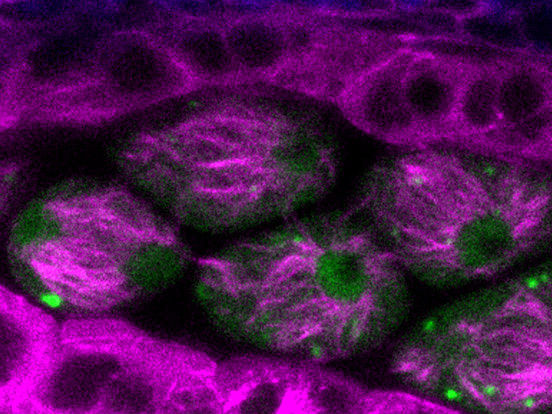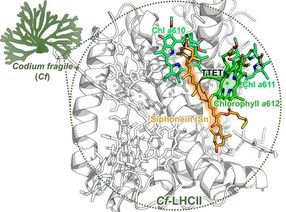How plants protect their genetic material from heat
Advertisement
Rising temperatures and more frequent heat waves are threatening the fertility of important crops. Researchers from the Department of Biology at the University of Hamburg have now identified a crucial protective mechanism against heat stress in plant cells - a promising basis for breeding climate-resistant varieties. Their study has been published in "Science Advances".

Photo: UHH/Schnittger In cells of the thale cress, so-called stress granules are formed in the heat, shown here as bright green dots. These are of crucial importance in the reproduction of the plant.
As in animals and humans, sexual reproduction also plays a role in many plants. They also form sex cells, so-called gametes. Flower pollen, for example, contains male gametes, which meet female gametes in the ovary during pollination. The formation of gametes is a tricky matter because the plant has to reduce the amount of genetic material they contain: unlike other cells, gametes only contain a single set of chromosomes instead of a double set. This is the prerequisite for the formation of new cells with only two sets of chromosomes - and not four - after the fusion of the female and male gametes.
An important player in this process is the TAM protein. "At normal temperatures, these protein molecules are scattered around inside the cell, but in hot conditions they form small groups together with other molecules, known as stress granules. These are supposed to protect the cell from heat, but exactly how this works is still unclear," explains Prof. Dr. Arp Schnittger from the Department of Biology at the University of Hamburg and lead author of the study. It was developed in collaboration with partners from China and Japan and is the first publication of the BIKON research network, which is funded by the City of Hamburg.
In order to find out more about the role of the TAM protein and the stress granules, Schnittger and his team carried out experiments with a model plant. The researchers combined various proteins of the thale cress (Arabidopsis thaliana) with a fluorescent protein so that these glowing proteins could be observed with special microscopes suitable for studying tissue.
In a second step, the TAM proteins were genetically modified. If they were no longer able to enter the stress granules as a result, defective germ cells with a double set of chromosomes were produced during reproduction. "This result shows that the transport of TAM proteins into the stress granules is crucial for successful reproduction under heat stress," explains Prof. Schnittger.
In a second series of experiments, the researchers were able to identify a specific region of the TAM protein that is responsible for uptake into stress granules and is absent in other proteins. "We have thus discovered a completely new, previously unknown regulatory mechanism that ensures the genetically stable reproduction of plants under heat," emphasizes Prof. Schnittger. Seed manufacturers can use this discovery in future to breed plants in which this regulatory mechanism is particularly strong.
Note: This article has been translated using a computer system without human intervention. LUMITOS offers these automatic translations to present a wider range of current news. Since this article has been translated with automatic translation, it is possible that it contains errors in vocabulary, syntax or grammar. The original article in German can be found here.



























































